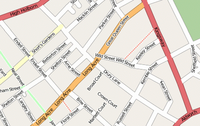Drury Lane (London)
Drury Lane is a 600 meter long street in central London in the Covent Garden district . It runs north of the Thames between High Holborn and Aldwych.
Naming
The street was named after the English statesman and knight Sir William Drury (1527–1579), whose London house was built here, then on Wych Street. The house later became the meeting point of Robert Devereux, 2nd Earl of Essex (1565-1601) and his followers, who on February 8, 1601 tried unsuccessfully to gain control of London and the Privy Council .
Development
In the 18th century the area deteriorated into one of the worst slums in London, with prostitution, cockpits (arena for cockfighting ) and pubs dominating the scene. The area was finally cleared at the beginning of the 20th century and rehabilitated as part of an urban development plan that stretched from Kingsway to Aldwych. Today Drury Lane is a narrow, densely built street with residential buildings and a few shops. The two theaters, Theater Royal, Drury Lane (often just called Drury Lane Theater ) with around 2,200 seats and the Gillian Lynne Theater with around 1,100 seats are located here.
Trivia
The first Sainsbury's store, now one of the largest supermarket chains in Great Britain, opened on Drury Lane in 1869.
Drury Lane is also the place where the 'Muffin Man' lives, a character from a children's song known in English-speaking countries and the Netherlands (here called 'Mosselman' ):
“Do you know the Muffin Man?
The Muffin Man, the Muffin Man.
Do you know the Muffin Man,
Who lives on Drury Lane? "
Sources and individual references
- ^ J Sainsbury plc, Our History ( January 15, 2010 memento in the Internet Archive ). Retrieved June 2, 2011
- ^ Conservatory Library, The Folk Song Index . Retrieved June 2, 2011
- British History Online: Drury Lane and Clare Market . Retrieved June 2, 2011
Coordinates: 51 ° 30 '51.9 " N , 0 ° 7' 18.4" W.

